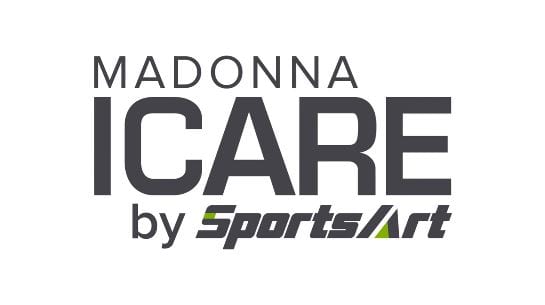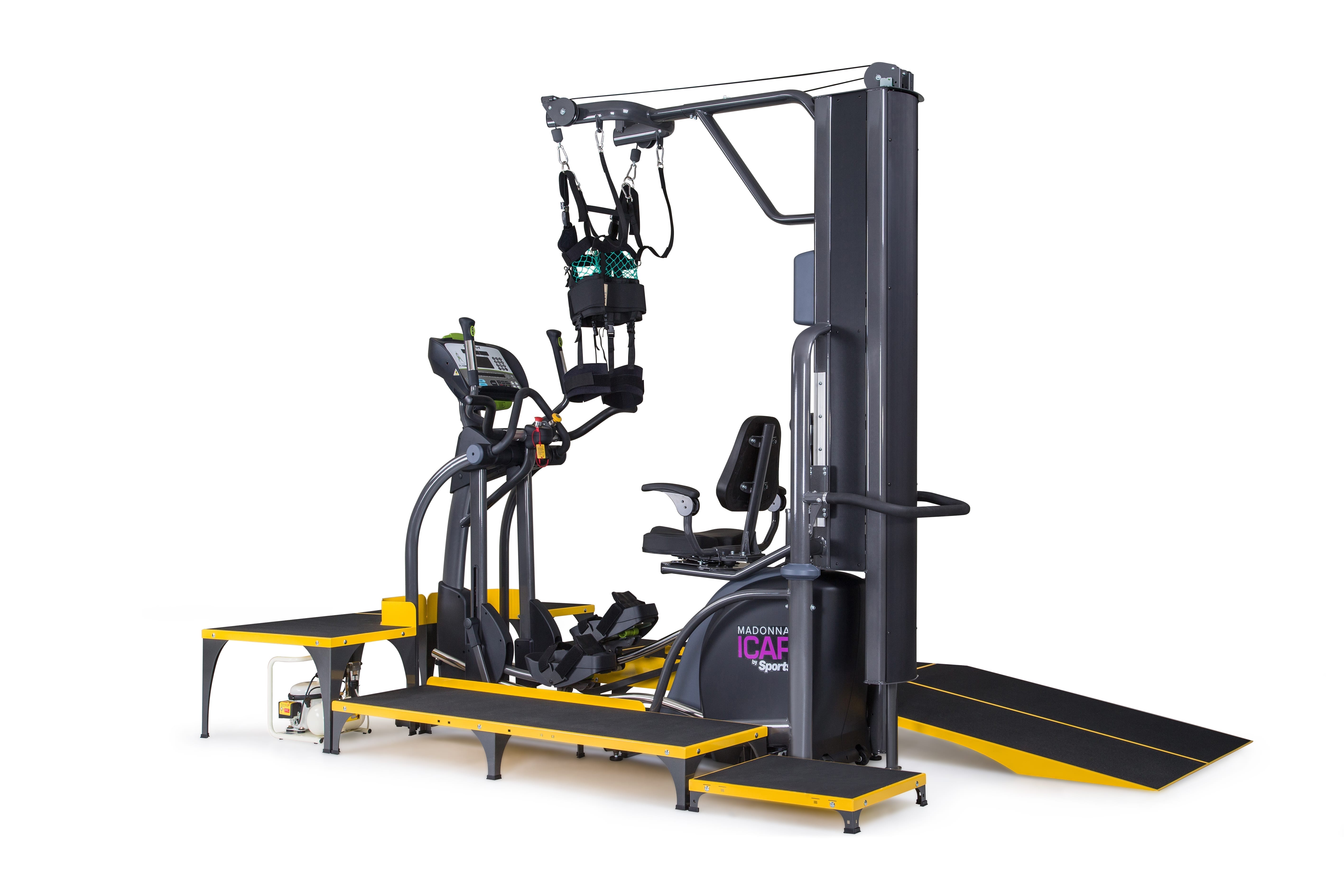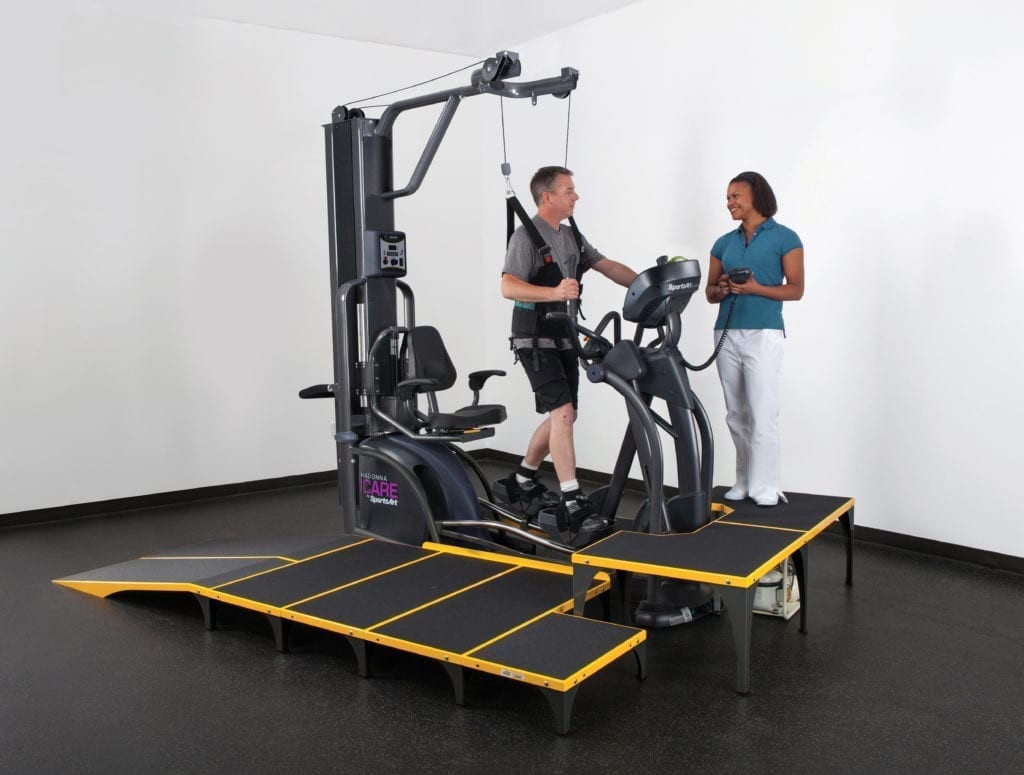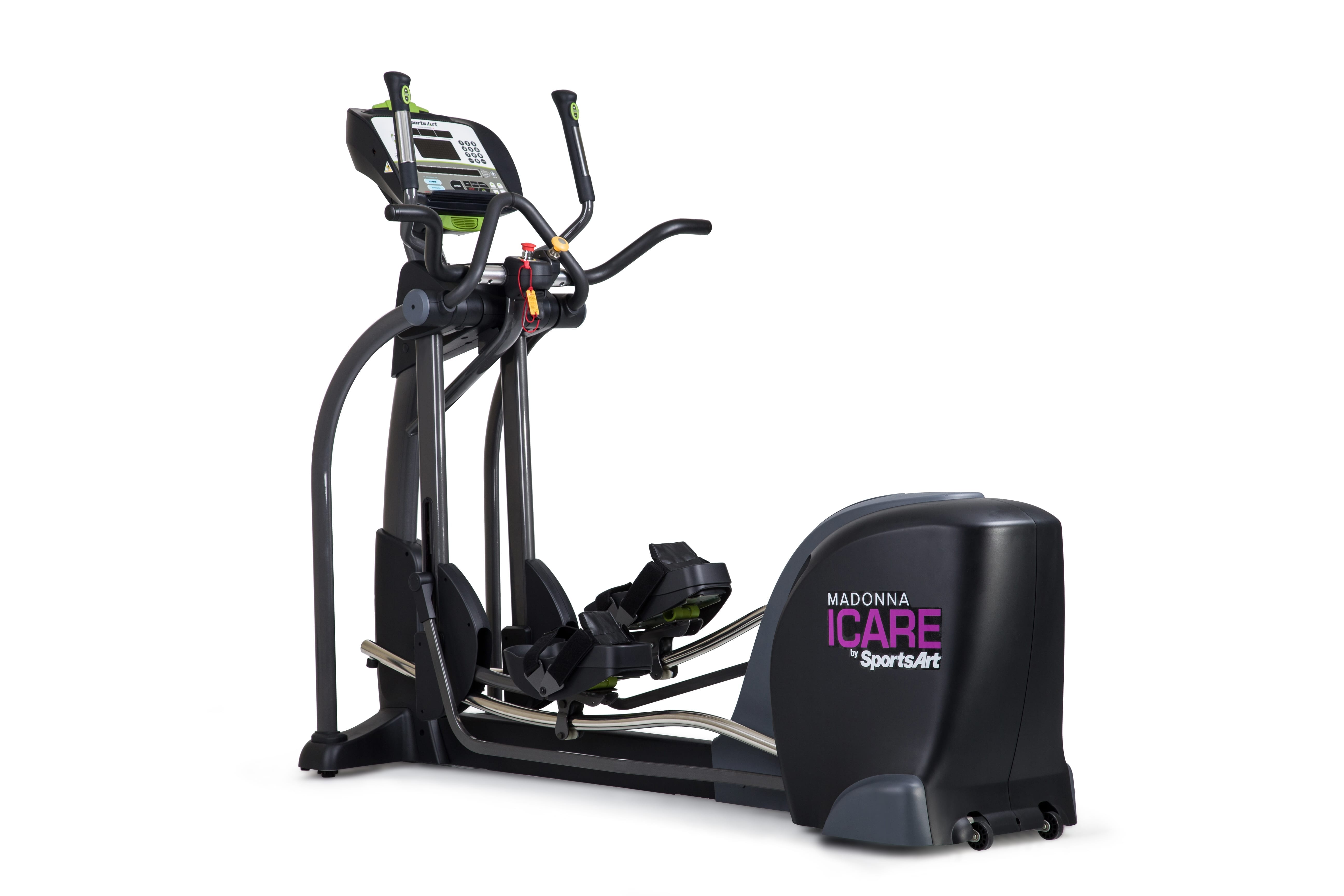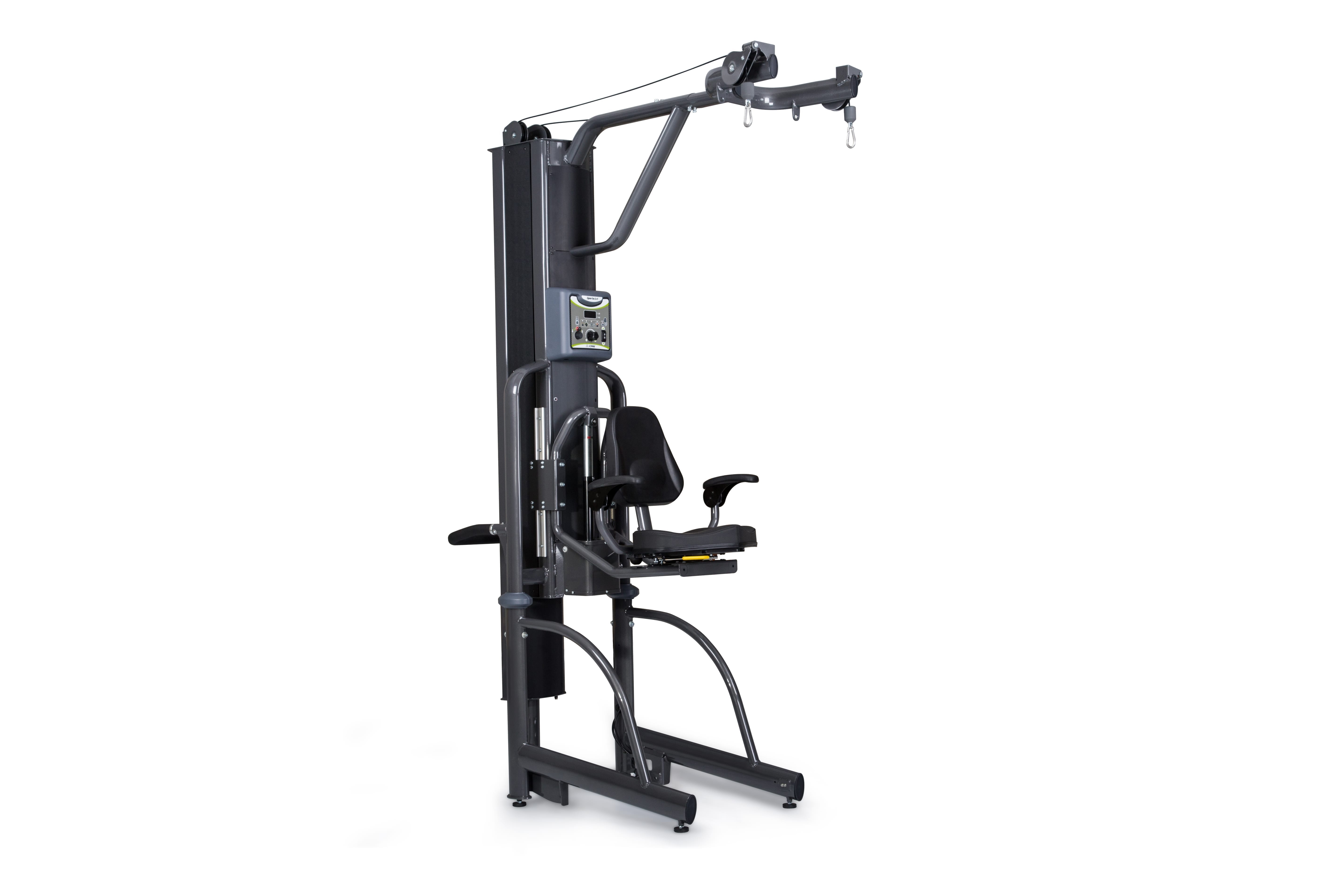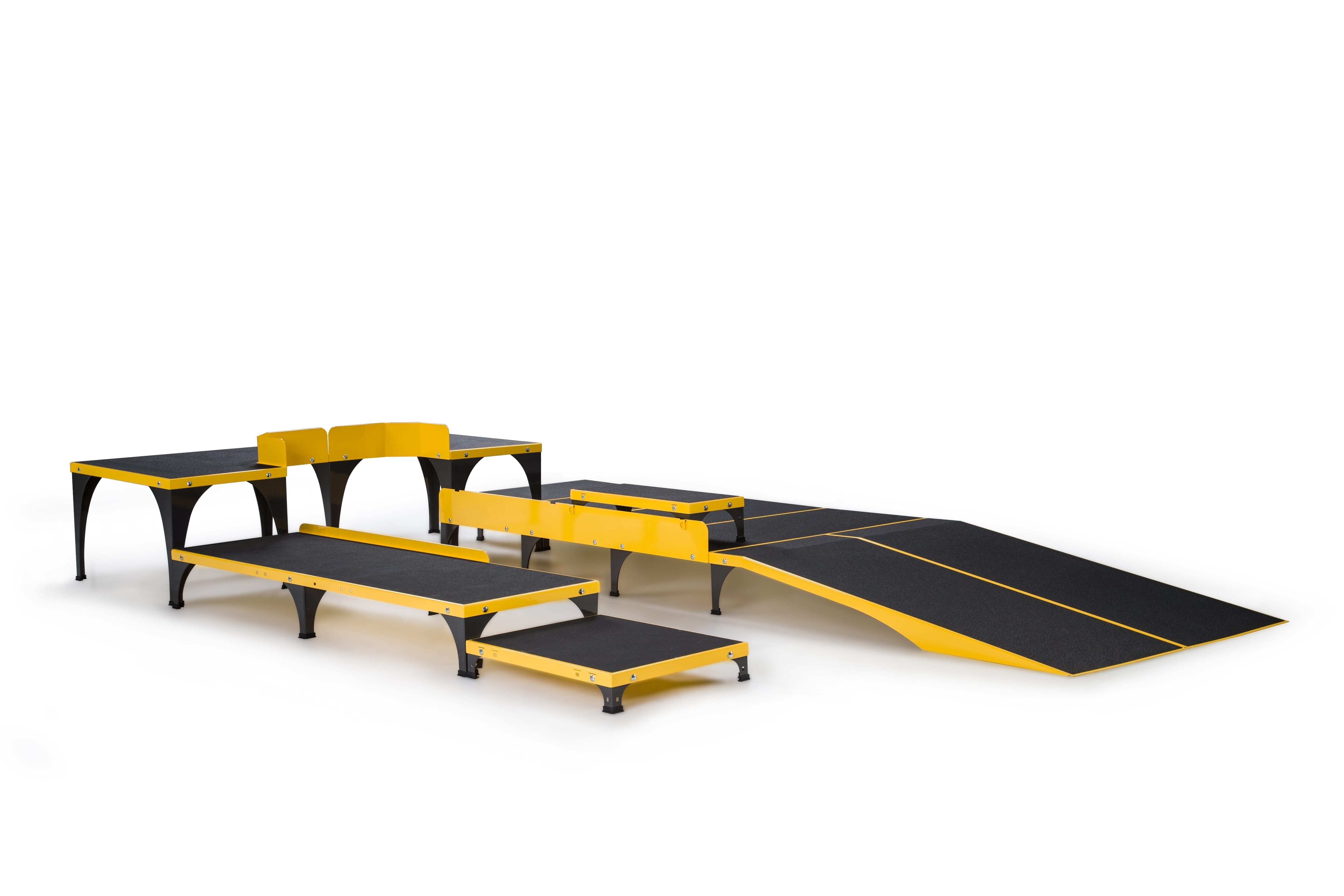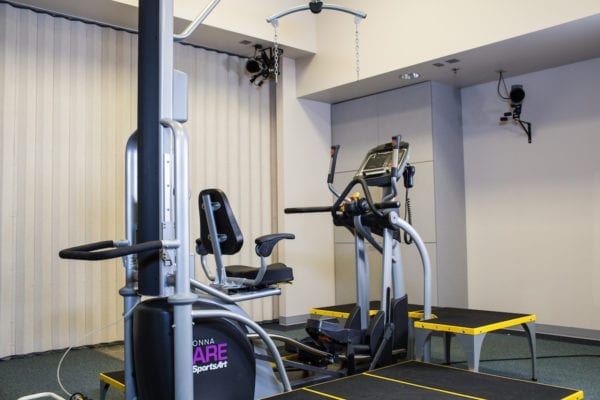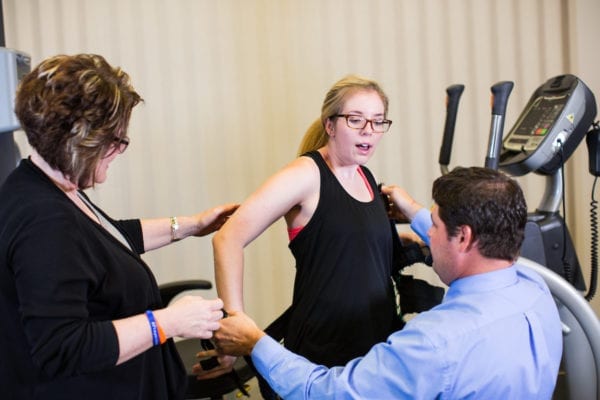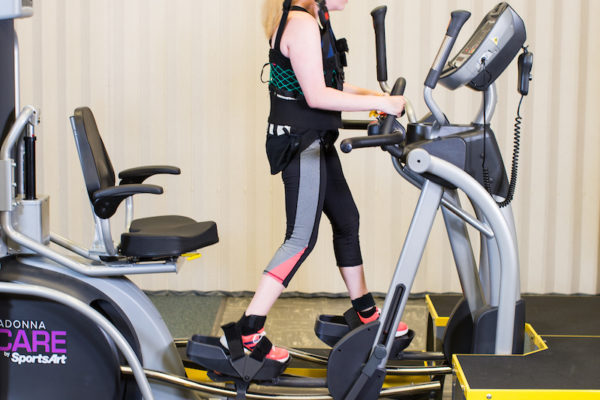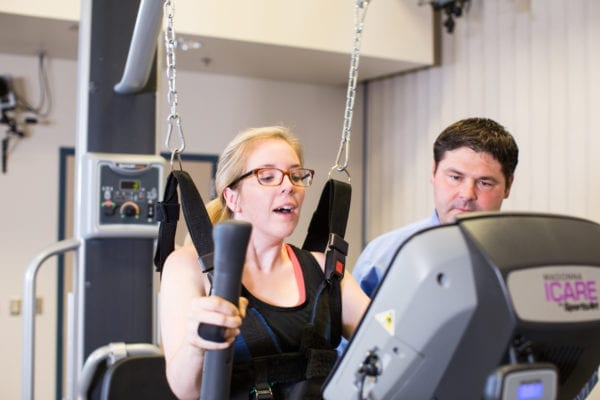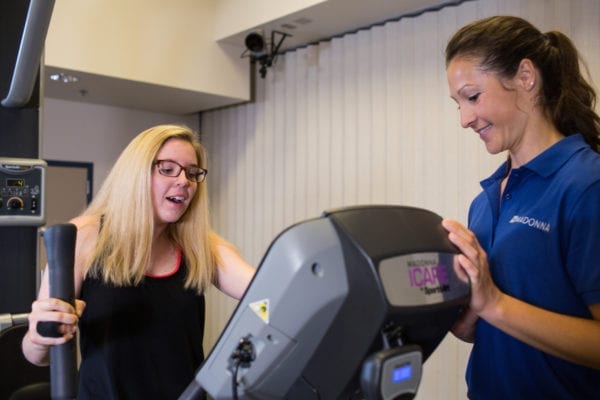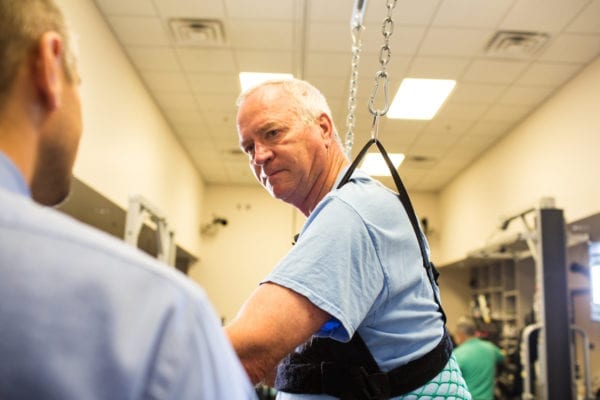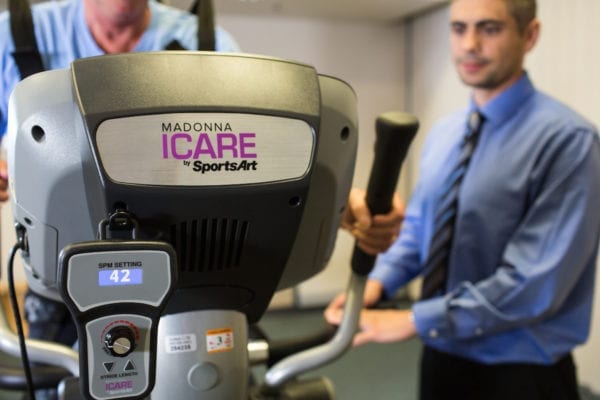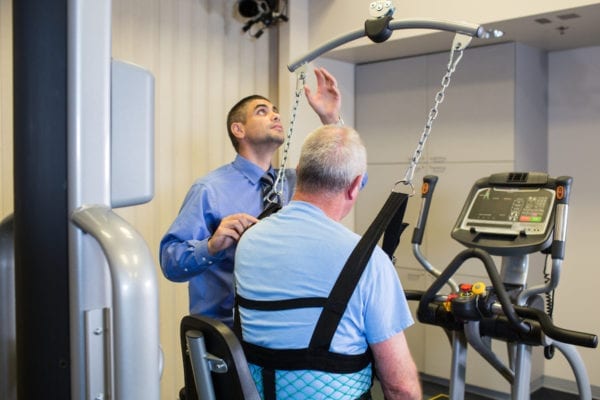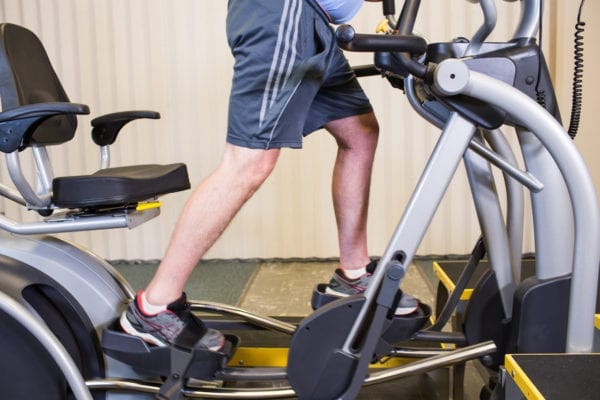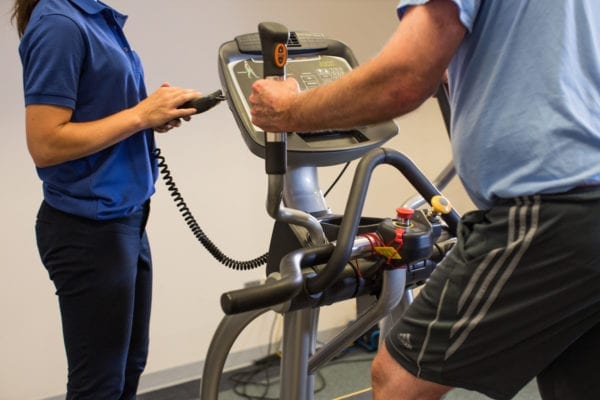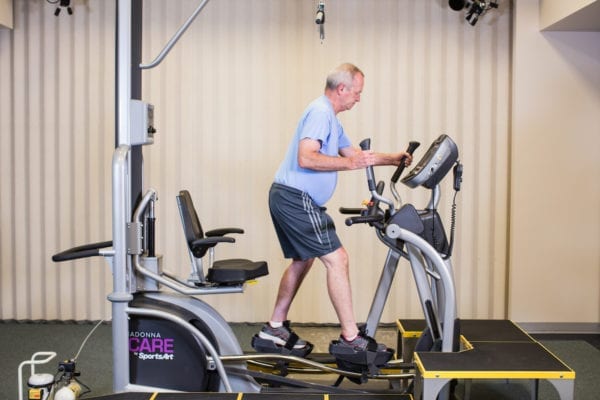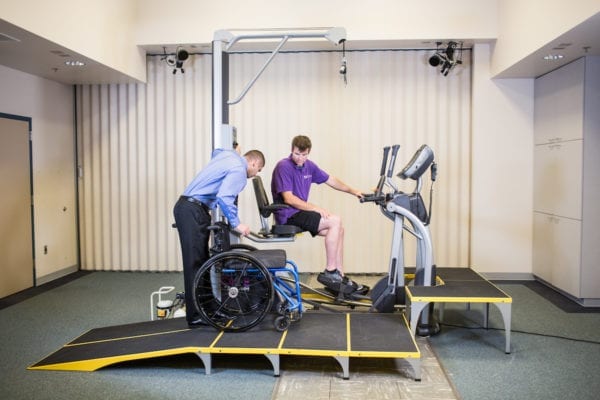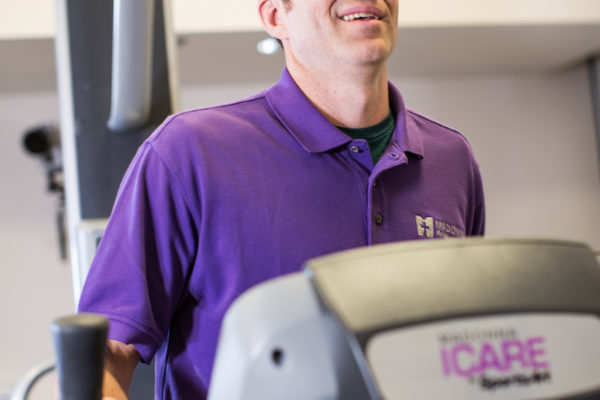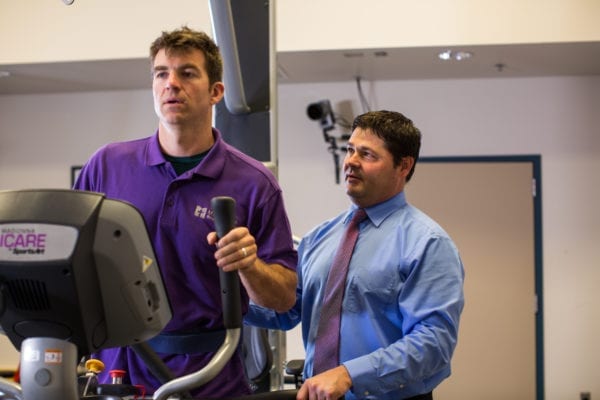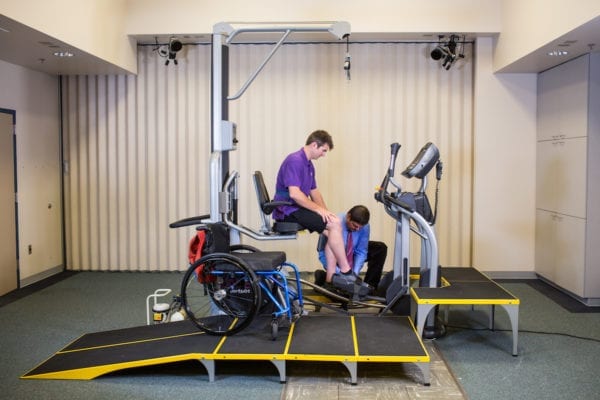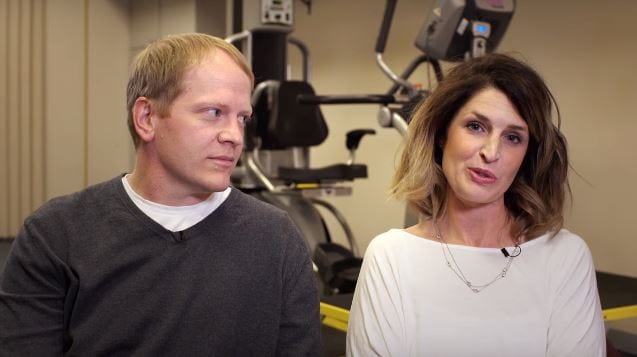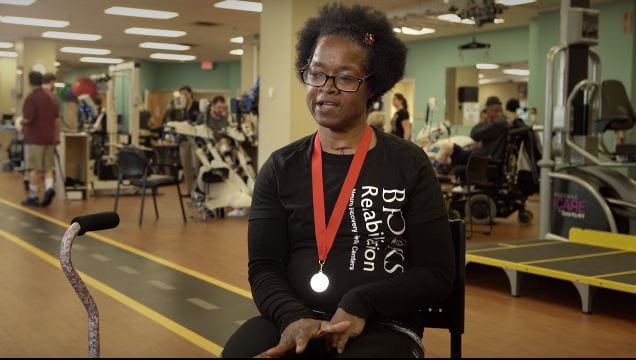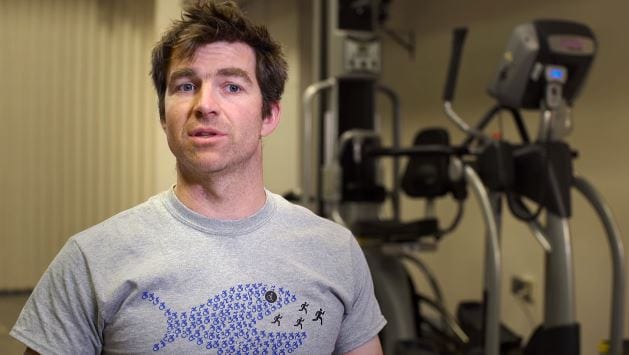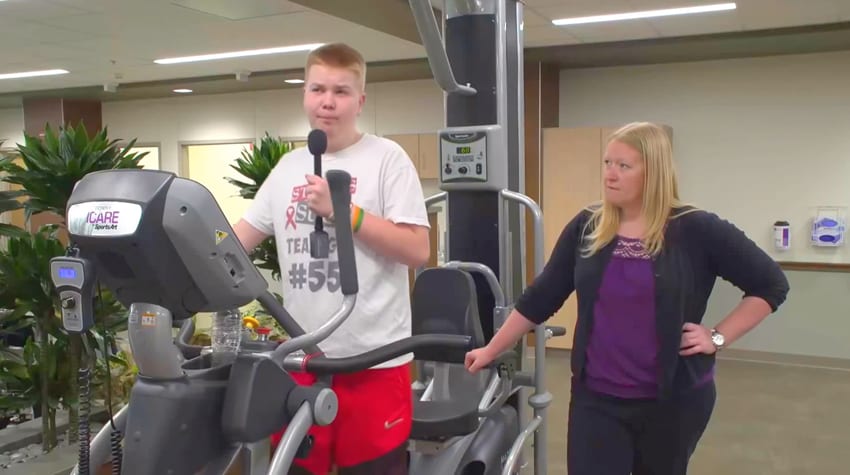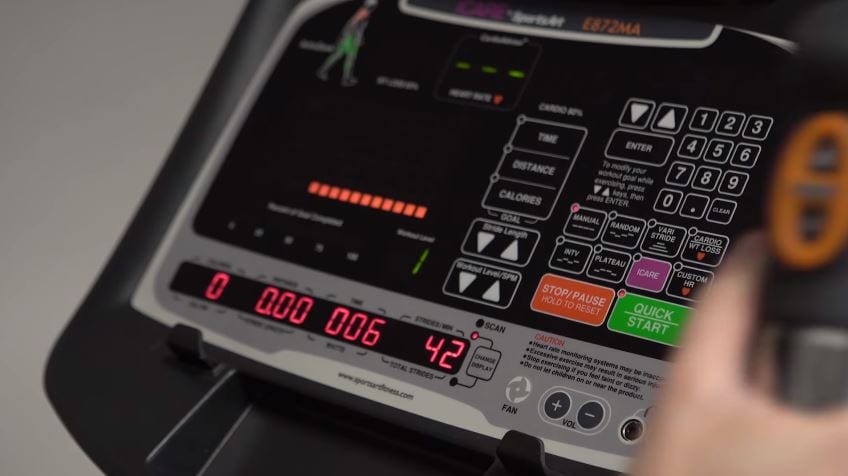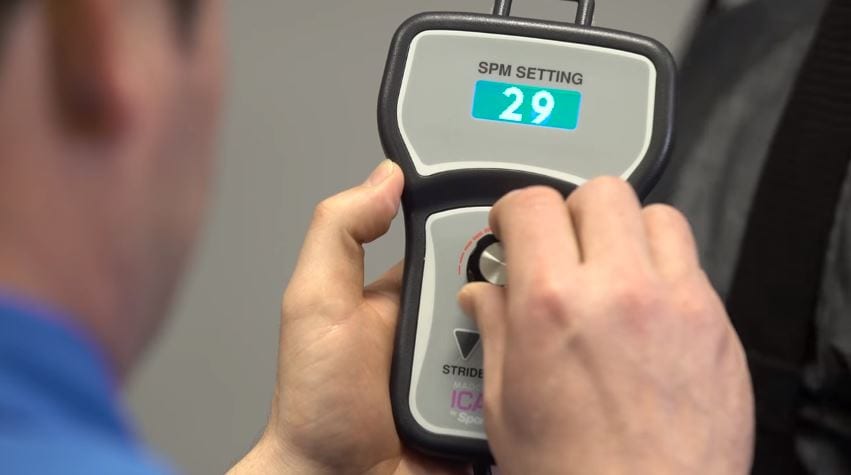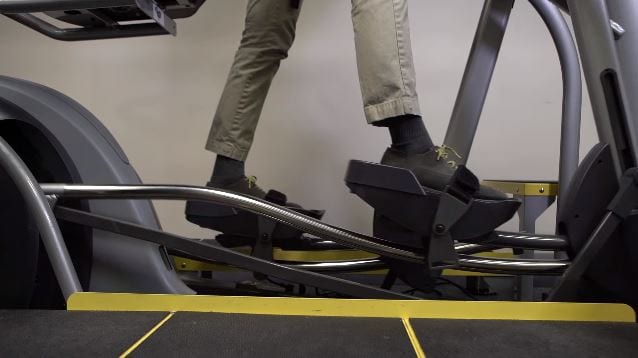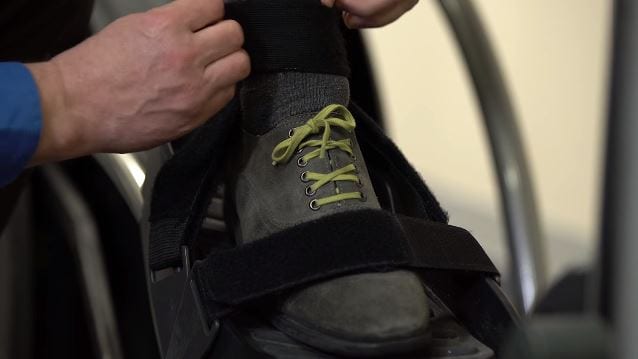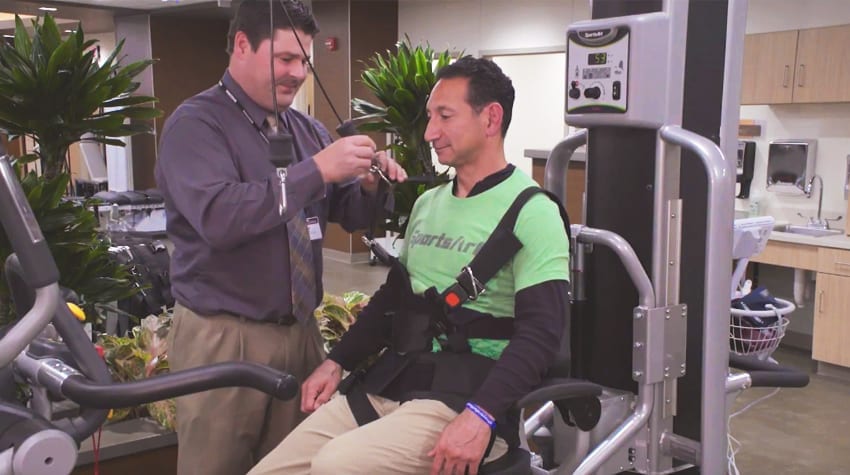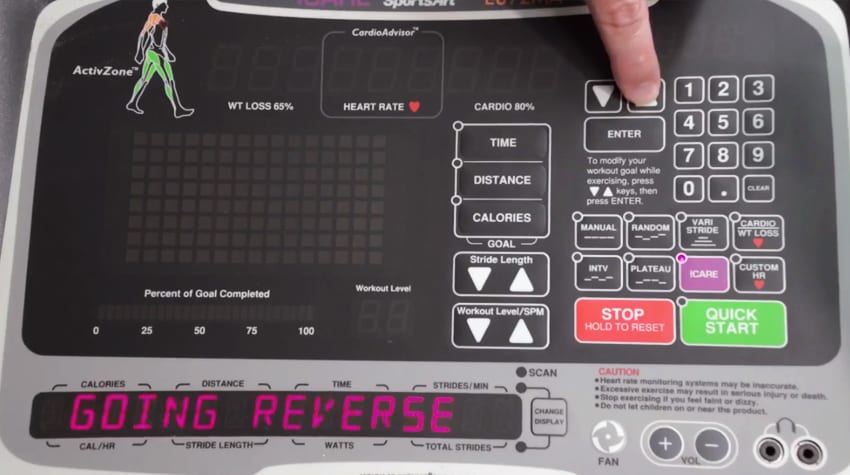Up to June 7, 2017
SELECTED ARTICLES AND BOOK CHAPTERS
Cesar GM, Buster TW, Burnfield JM. Cardiorespiratory fitness, balance, and walking improvements in an adolescent with cerebral palsy (GMFCS II) and autism after motor-assisted elliptical training. European Journal of Physiotherapy. Accepted for publication.
Burnfield JM, Buster TW, Pfeifer CM, Irons SL, Cesar GM, Nelson CA (2018). Adapted motor-assisted elliptical for rehabilitation of children with physical disabilities. ASME Journal of Medical Devices, published online ahead of print, September 26, 2018. https://doi.org/DOI:10.1115/1.4041588
Pfeifer CM, Rowan D, Buster TW, Cesar GM, Irons SL, Burnfield JM (2018). Design and validation of a heart rate and speed monitoring device with Intelligently Controlled Assistive Rehabilitation Elliptical. ASME Journal of Medical Devices, published online ahead of print, August 29, 2018. https://doi.org/DOI:10.1115/1.4041337
Williams NA, Burnfield JM. Psychological difficulties and parental well-being in children with musculoskeletal problems in the 2011/2012 National Survey of Children’s Health. Rehabilitation Psychology. Published online ahead of print, October 8, 2018. https://doi.org/DOI:10.1037/rep0000251
Burnfield JM, Cesar GM, Buster TW, Irons SL, Pfeifer CM (2018). Walking and fitness improvements in child with diplegic CP following motor-assisted elliptical intervention. Pediatric Physical Therapy, 30(4):E1-E7. https://doi.org/DOI:10.1097/PEP.0000000000000541
Burnfield JM, Pfeifer CM, Kwapiszeski S, Irons SL, Buster TW, Cesar GM (2018). Impact of ICARE training speed and motor assistance on cardiovascular response. Cardiopulmonary Physical Therapy Journal, published online ahead of print, September 10, 2018. DOI: 10.1097/CPT.0000000000000098.
Cesar GM, Buster TW, Burnfield JM (2017). Should gait outcomes be the primary focus in pediatric gait rehabilitation? Journal of Novel Physiotherapies, 7(3):1000342. DOI: 10.4172/2165-7025.1000342
Burnfield JM, Cesar G, Buster TW, Irons SL, Nelson CA (2017). Kinematic and muscle demand similarities between motor-assisted elliptical training and walking: Implications for pediatric gait rehabilitation. Gait & Posture, 51:194-200. DOI: 10.1016/j.gaitpost.2016.10.018
Cesar GM, Pfeifer CM, Burnfield JM (2017). 3-Dimensional versus 2-dimensional comparison of knee valgus collapse during vertical jump: Clinical implications for ACL risk of injury assessment. Journal of Sports Medicine and Therapy, 2:32-38.
Cesar GM, Edwards H, Hasenkamp R, Burnfield JM (2017) Prediction of athletic performance of male and female athletes measured by triple hop for distance. Trends in Sport Sciences, 1(24): 19-25.
Burnfield JM, Buster TW, Goldman AJ, Corbridge LM, Hanigan K (2016). Partial body weight support treadmill training speed influences paretic and non-paretic muscle activation and stride characteristics during acute stroke rehabilitation. Human Movement Science. (47): 16-28. DOI: 10 1016/j.humov.2016.01.012
Buster TW, Chernyavskiy P, Harms NR, Kaste G, Burnfield JM (2016). Assessment of balance using computerized dynamic posturography in individuals with and without chronic severe traumatic brain injury. Brain Injury. 30(10):1249-1255. DOI: 10.1080/02699052.2016.1183822.
Pfeifer CM, Burnfield JM, Cesar GM, Twedt MH, Hawks JA (2016). Video Capture and Post Processing Technique for Approximating 3D Projectile Trajectory. Journal of Sports Technology. DOI: 10.1080/19346182.2016.1248974.
Cesar GM, Tomasevicz C, Burnfield JM (2016). Frontal plane comparison between drop jump and vertical jump: Implications for the assessment of ACL risk of injury. Sports Biomechanics. 15(4):440-449. DOI: 10.1080/14763141.2016.1174286.
Madrigal LA, Wilson PB, Burnfield JM (2016). Nutritional regrets and knowledge in National Collegiate Athletic Association Division I athletes: Establishing a foundation for educational interventions. Journal of Issues in Intercollegiate Athletics, 9:1-16.
Wilson PB, Madrigal LA, Burnfield JM (2016). Weight control practices of Division I National Collegiate Athletic Association athletes. The Physician and Sportsmedicine, 44(2): 170-176. DOI: 10.1080/00913847.2016.1149420.
Irons SL, Brusola GA, Buster TW, Burnfield JM (2015). Novel ICARE Intervention Improves Six-Minute Walk Test and Oxygen Cost for an Individual with Progressive Supranuclear Palsy. Cardiopulmonary Physical Therapy Journal, 26(2):36-41. DOI: 10.1097/CPT.0000000000000007
Nelson CA, Stolle CJ, Burnfield JM, Buster TW (2015). Modification of the Intelligently Controlled Assistive Rehabilitation Elliptical (ICARE) system for pediatric therapy. Published online, ASME Journal of Medical Devices, 9(4): 6 pages. DOI: 10.1115/1.4030276.
Bethoux F, Rogers HL, Nolan KJ, Abrams GM, Annaswamy T, Brandstater M, Browne B, Burnfield JM, Feng W, Freed MJ, Geis C, Greenberg J, Gudesblatt M, Ikramuddin F, Jayaraman A, Kautz SA, Lutsep H, Madhavan S, Meilahn J, Pease WS, Rao N, Seetharama S, Sethi P, Turk MA, Wallis RA, Kufta C (2015). Long-term Follow-up to a Randomized Controlled Trial Comparing Peroneal Nerve Functional Electrical Stimulation to an Ankle Foot Orthosis for Patients with Chronic Stroke. Neurorehabilitation and Neural Repair, 29(10):911-922. DOI: 10.1177/1545968315570325.
Koch Fager S, Burnfield JM (2015). Speech recognition for environmental control: Effect of microphone type, dysarthria and severity on recognition results. Assistive Technology, 27(4):199-207. DOI: 10.1080/10400435.2015.1024349.
Bethoux F, Rogers HL, Nolan KJ, Abrams GM, Annaswamy T, Brandstater M, Browne B, Burnfield JM, Feng W, Freed MJ, Geis C, Greenberg J, Gudesblatt M, Ikramuddin F, Jayaraman A, Kautz SA, Lutsep H, Madhavan S, Meilahn J, Pease WS, Rao N, Seetharama S, Sethi P, Turk MA, Wallis RA, Kufta C (2014). The effects of peroneal nerve functional electrical stimulation versus ankle-foot orthosis in patients with chronic stroke: a randomized controlled trial. Neurorehabilitation and Neural Repair, 28(7):688-697. DOI: 10.1177/1545968314521007.
Nelson CA, Burnfield JM, Gu L (2014). Mobility-Enhancing Fall-Prevention Device for Physical Rehabilitation. Journal of Medical Devices 8(2), 020929. DOI: 10.1115/1.4027029 [Technical Brief].
Nelson CA, Burnfield JM, Gu L, Ems H, Ens Q (2014). Forearm Attachment for Post-Amputation Weight Lifting Exercise. Journal of Medical Device 8(2), 020930. DOI: 10.1115/1.4027030 [Technical Brief].
Burnfield JM, Irons SL, Buster TW, Taylor AP, Hildner GA, Shu Y (2014). Comparative analysis of speed’s impact on muscle demands during partial body weight support motor-assisted elliptical training, Gait & Posture. 39(1): 314-320. DOI: https://dx.doi.org/10.1016/j.gaitpost.2013.07.120
Koch Fager S, Burnfield JM (2014). Patients’ experiences with technology during inpatient rehabilitation: opportunities to support independence and therapeutic engagement. Disability and Rehabilitation: Assistive Technology, 9(2):121-127: DOI: 10.3109/17483107.2013.787124.
Bunfield JM, Norkin CC (2013). Gait Analysis, Chapter 7. O’Sullivan SB, Schmitz TJ, and Fulk G (Eds). Physical Rehabilitation, Sixth Edition. F.A. Davis Company. Philadephia, PA.
Burnfield JM, McCrory B, Shu Y, Buster TW, Taylor AP, Goldman AJ (2013). Comparative kinematic and electromyographic assessment of clinician- and device-assisted sit-to-stand transfers in patients with stroke. Physical Therapy, 93(10):1331-1341. DOI: 10.2522/ptj.20120500
Buster TW, Burnfield JM, Taylor AP, Stergiou, N (2013). Lower extremity kinematics during walking and elliptical training in individuals with and without traumatic brain injury. Journal of Neurologic Physical Therapy. 37(4): 176-186. DOI: 10.1097/NPT.0000000000000022
Burnfield JM, Shu Y, Buster TW, Taylor A, McBride MM, Krause ME (2012). Kinematic and electromyographic analysis of normal and device-assisted sit to stand transfers. Gait and Posture, 36(3):516-522. DOI: https://dx.doi.org/10.1016/j.gaitpost.2012.05.002
Burnfield JM, Eberly V, Gronley JK, Perry J, Yule W, Mulroy SJ (2012). Impact of Stance Phase Microprocessor-Controlled Knee Prosthesis on Ramp Negotiation and Community Walking Function in K2 Level Transfemoral Amputees. Prosthetics and Orthotics International, 36(1):101-110. DOI: 10.1177/0309364611431611
Burnfield JM, Shu Y, Buster TW, Taylor A, Nelson CA (2011). Impact of elliptical trainer ergonomic modifications on perceptions of safety, comfort, workout and usability by individuals with physical disabilities and chronic conditions. Physical Therapy, 91(11)1604-1617. DOI:https://doi.org/10.2522/ptj.20100332
Nelson CA, Burnfield JM, Shu Y, Buster TW, Taylor A, Graham A (2011). Modified elliptical machine motor-drive design for assistive gait rehabilitation. Transactions of the ASME Journal of Medical Devices, 5:021001.1-021001.7. DOI:10.1115/1.4003693
Burnfield JM, Shu Y, Buster TW, Taylor A (2010). Similarity of joint kinematics and muscle demands between elliptical training and walking: Implications for practice. Physical Therapy. 90(2). 289-305. DOI:https://doi.org/10.2522/ptj.20090033
Kulig K, Reischl SF, Pomrantz AB, Burnfield JM, Mais-Requejo S, Thordarson DB, Smith RW (2009). Non-operative management of posterior tibialis tendon dysfunction using orthoses and resistive exercise: A randomized clinical trial. Physical Therapy, 89:26-36.
Kulig K, Burnfield JM (2008). The role of biomechanics in orthopedic and neurological rehabilitation. Acta of Bioengineering and Biomechanics, 10:1-14.
Bashford GR, Tomsen N, Arya S, Burnfield JM, Kulig K (2008). Tendinopathy discrimination by use of spatial frequency parameters in ultrasound B-mode images. IEEE Transactions on Medical Imaging, 27(5):608-615.
Sasaki K, Neptune RR, Burnfield JM, Mulroy SJ (2008). Muscle contributions to body support and propulsion in toe walking. Gait and Posture,27:440-446.
Burnfield JM, Powers CM (2007). The Role of Center of Mass Kinematics in Predicting Peak Utilized Coefficient of Friction during Walking. Journal of Forensic Sciences, 52(6):1328-1333.
Burnfield JM, Jorde AG, Augustin TR, Augustin TA, Bashford GR (2007). Variations in plantar pressure variables across five cardiovascular exercises. Medicine and Science in Sports and Exercise, 39(11):2012-2020.
Neptune RR, Burnfield JM, Mulroy SJ (2007). The neuromuscular demands of toe walking: A forward dynamics simulation analysis. Journal of Biomechanics, 40(6):1293-1300.
Burnfield JM, Powers CM(2006). Prediction of slips: An evaluation of utilized coefficient of friction and available slip resistance. Ergonomics, 49(10):982-995.
Kulig K, Pomrantz AB, Burnfield JM, Reischl SF, Mais-Requejo S, Thordarson DB, Smith RW (2006). Non-operative management of posterior tibialis tendon dysfunction: design of a randomized clinical trial [NCT00279630]. BMC Musculoskeletal Disorders, 7:49.
Burnfield JM, Powers CM (2006). Normal and Pathological Gait, Chapter 16. In Placzek J, Boyce D (Eds). Orthopaedic Physical Therapy Secrets, Second Edition. Elsevier, Inc. Philadelphia, PA.
Mohamed OS, Cerny K, Jones W, Burnfield JM (2005). Effect of terrain on foot pressures during walking. Foot and Ankle International, 26(10): 859-869.
Burnfield JM, Tsai Y-J, Powers CM (2005). Comparison of Utilized Coefficient of Friction during Different Walking Tasks in Persons with and without a Disability. Gait and Posture, 22(1): 82-88.
Kulig K, Burnfield JM, Reischl S, Requejo SM, Blanco, CE, Thordarson, DB (2005). Effect of Foot Orthoses on Tibialis Posterior Activation in Persons with Pes Planus. Medicine and Science in Sports and Exercise, 37(1): 24-29.
Perry J, Burnfield JM, Newsam CJ, Conley P (2004). Energy expenditure and gait characteristics of a person with bilateral amputations walking with the “C-Leg” compared to stubby and conventional articulating prostheses. Archives of Physical Medicine and Rehabilitation, 85(10):1711-1717.
Burnfield JM, Few CD, Mohamed OS, Perry J (2004). The influence of velocity and footwear on walking plantar pressures in the older adult. Clinical Biomechanics, 19(1):78-84.
Perry J, Weiss W, Burnfield JM, Gronley JK (2004). The supine hip extensor manual muscle test. Archives of Physical Medicine and Rehabilitation, 85(8):1345-1350.
Kulig K, Burnfield JM, Requejo SM, Sperry M, Terk MR (2004). Selective activation of the tibialis posterior: Evaluation by Magnetic Resonance Imaging. Medicine & Science in Sports & Exercise, 36(5):862-867.
Burnfield JM, Powers CM (2003). Influence of age and gender on utilized coefficient of friction during walking at different speeds. Metrology of Pedestrian Locomotion and Slip Resistance, STP #1424:3-16.
Perry J, Burnfield JM, Gronley JK, Mulroy SJ (2003). Toe walking: Muscular demands at the ankle and knee. Archives of Physical Medicine and Rehabilitation, 84:7-16.
Powers CM, Burnfield JM, Lim P, Brault JR, Flynn JE (2002). Utilized coefficient of friction during walking: Static estimates exceed measured values. Journal of Forensic Sciences, 47(6):1303-1308.
Bober T, Kulig K, Burnfield JM, Pietraszewski B (2002). Development of predictive equations for dynamic torque characteristics generated by appendicular musculature. Acta of Bioengineering and Biomechanics, 4(2):49-60.
Burnfield JM, Josephson KR, Powers CM, Rubenstein LZ (2000). The influence of lower extremity joint torque on gait characteristics in elderly men. Archives of Physical Medicine and Rehabilitation, 81(9):1153-7.
SELECTED ABSTRACTS
Pfeifer CM, Whorley BA, Buster TW, Cesar GM, Burnfield JM (2018). Investigation of center of pressure during gait and motor-assisted elliptical training in adults. Archives of Physical Medicine and Rehabilitation, 99(12):e206. DOI: https://doi.org/10.1016/j.apmr.2018.09.052.
Burnfield JM, Cesar GM, Buster TW, Pfeifer CM, Anglehart CM, Klem CJ, Dasgupta P, Nelson CA (2018). Perceived value of modular self-reconfigurable robot for reaching/retrieving by individuals with SCI. Archives of Physical Medicine and Rehabilitation, 99(12):e209-210. DOI: https://doi.org/10.1016/j.apmr.2018.09.063
Huang C-K, Buster TW, Siu K-C, Burnfield JM (2018). Combining virtual reality gaming with motor-assisted elliptical impacts children’s engagement in exercise. Archives of Physical Medicine and Rehabilitation, 99(12):e195. DOI: https://doi.org/10.1016/j.apmr.2018.09.020
Burnfield JM. Robotic ICARE Technology for Walking, Fitness, Balance and Arm Rehabilitation: An Integrated and Affordable Approach. The 4th China Rehabilitation Forum (CRF2018). Shanghai, China. April 20, 2018.
Burnfield JM. Improving Walking and Fitness Following Neurologic Injury: Practical Solutions to Complex Challenges. 2018年中美康复医学与研究论坛 / 2018 Sino-US Rehabilitation Medicine and Research Symposium. Shanghai, China. January 15, 2018.
Cesar GM, Irons SL, Garbin A, Eckels E, Buster TW, Burnfield JM (2017). Child with traumatic brain injury improved gait abilities following intervention with pediatric motor-assisted elliptical training: A case report. Journal of Neurologic Physical Therapy, 41(1):84. DOI: 10.1097/NPT.0000000000000156.
Burnfield JM, Terryberry-Spohr L, Tran J (2016). Affordable Motor-assisted Elliptical Training to Improve Physical, Cognitive, Psychosocial and Health Outcomes Across Rehabilitation Continuum. 75-minute Symposium, Conference proceedings, 2016 American Congress of Rehabilitation Medicine (ACRM) 93rd Annual Conference: Progress in Rehabilitation Research. Chicago, IL, November 2.
Irons SL, Burnfield JM, Buster TW, Karkowski-Schelar E, Johns E (2016). Individuals with multiple sclerosis improved walking endurance and decreased fatigue following motor-assisted elliptical training intervention. Archives of Physical Medicine and Rehabilitation, 97(10):e34. DOI: https://dx.doi.org/10.1016/j.apmr.2016.08.100
Burnfield JM, Buster TW, Irons SL, Cesar GM, Nelson CA, Rech NR, Nichols EM (2016). Pediatric walking vs. training on prototype motor-assisted elliptical: Kinematic comparison at self-selected comfortable speed. Archives of Physical Medicine and Rehabilitation, 97(10):e99. DOI: https://dx.doi.org/10.1016/j.apmr.2016.08.306
Burnfield JM, Irons SL, Cesar GM, Buster TW, Khot R, Nelson CA (2016). Pedi-ICARE training improves walking and endurance of child with cerebral palsy. Archives of Physical Medicine and Rehabilitation, 97(12):e19-e20. DOI: https://dx.doi.org/10.1016/j.apmr.2016.09.053
Burnfield JM, Buster TW, Irons SL, Rech N, Cesar GM, Pfeifer CM, Nelson CA (2016). Pediatric Intelligently Controlled Assistive Rehabilitation Elliptical for Walking and Fitness: Prototype Development and Biomedical Analysis [Abstract]. RESNA/NCART (Rehabilitation Engineering Society of North America/National Coalition for Assistive and Rehab Technology) 2016 annual convention, July 10-14, Arlington, VA.
Pfeifer CM, Burnfield JM, Kota S, Buster TW, Irons SL, Rowen DA, Nelson CA (2016). Positive Reinforcement System Design for Therapeutic Devices [Abstract]. RESNA/NCART (Rehabilitation Engineering Society of North America/National Coalition for Assistive and Rehab Technology) 2016 annual convention, July 10-14, Arlington, VA.
Pfeifer CM, Burnfield JM, Kota S, Buster TW, Irons SL, Sulski C, Nelson CA (2016). Design of a Custom Heart-Rate Control System for the Pediatric Intelligently Controlled Assistive Rehabilitation Elliptical [Abstract]. RESNA/NCART (Rehabilitation Engineering Society of North America/National Coalition for Assistive and Rehab Technology) 2016 annual convention, July 10-14, Arlington, VA.
Buster TW, Burnfield JM, Irons SL, Nelson CA, Trejo LH, Leutzinger TJ (2016). Pediatric walking vs. training on a prototype motor-assisted elliptical: kinematic and EMG comparisons at self-selected fast speeds [Abstract]. Conference proceedings, 2016 Annual Meeting Gait and Clinical Movement Analysis Society. Memphis, TN, May 17-20, 2016.
Burnfield JM, Irons SL, Buster TW (2016). An individual with progressive supranuclear palsy demonstrates improvements in walking distance and efficiency following a motor-assisted elliptical training intervention [Abstract]. Conference proceedings, 9th World Congress for Neurorehabilitation. Philadelphia, PA, May 12, 2016.
Burnfield JM, Buster TW, Irons SL (2016). Individuals post stroke improved walking endurance and efficiency following motor-assisted elliptical training intervention [Abstract]. Conference proceedings, 9th World Congress for Neurorehabilitation. Philadelphia, PA, May 12, 2016.
Buster TW, Burnfield JM (2016). Movement variability during walking and elliptical exercise for individuals with chronic severe traumatic brain injuries [Abstract]. Conference proceedings, 9th World Congress for Neurorehabilitation. Philadelphia, PA, May 12, 2016.
Rasmussen CM, Duncan ZE, Edwards H, Burnfield JM, Cesar GM (2016). Lower extremity postural and force imbalance between healthy and injured football athletes. Proceedings, American Society of Biomechanics Annual Conference. Raleigh, NC, 2016.
Edwards H, VanLent A, Rasmussen CM, Burnfield JM, Cesar GM (2016). Triple hop for distance as a measure of athletic performance. Medicine and Science in Sports and Exercise, Volume 48:5 Supplement 1:1043. DOI: 10.1249/01.mss.0000488140.36006.c7.
Duncan ZE, Tomasevicz CL, Burnfield JM, Cesar GM (2016). Kinematic comparison between drop jump and vertical jump: Implications for ACL risk of injury assessment. Medicine and Science in Sports and Exercise, Volume 48:5 Supplement 1:734. DOI: 10.1249/01.mss.0000487203.72972.96
Nelson CA, Stolle CJ, Burnfield JM, Buster TW (2015). Synthesis of a rehabilitation mechanism replicating normal gait [Technical Paper]. Conference Proceedings, 14th World Congress in Mechanisms and Machine Science; DOI: 10.6567/IFToMM.14TH.WC.OS1.016. Taipei, Taiwan, October 25-30, 2015.
Pfeifer CM, Burnfield JM, Twedt MH, Cesar GM, Hasenkamp RM, Hawks JA (2015). Post processing technique for approximating projectile trajectory in 3D space. Conference Proceedings, American Society of Biomechanics 39th Annual Meeting: 1316-1317. Columbus, Ohio, August 5-8, 2015.
Trejo LH, Buster TW, Stolle CJ, Nelson CA, Burnfield JM (2014). Influence of rocker and crank arm lengths on Intelligently Controlled Assistive Rehabilitation Elliptical (ICARE) coupler trajectories. Proceedings, Midwest BME Career Conference. p. 31
Bashford GR, Burnfield JM, Pérez LC (2013). Physical Activity Discrimination Improvement using Accelerometers and Wireless Sensor Network Localization. 50th International ISA Biomedical Sciences Instrumentation Symposium / Rocky Mountain Bioengineering Symposium.Colorado Spring, CO.
Burnfield JM, Nelson CA, Buster TW, Taylor AP (2012). Affordable technology addresses walking and fitness deficits across rehabilitation continuum of care. 10th Annual Conference of the American Medical Rehabilitation Providers Association. San Diego, CA.
Watt BP, Burnfield JM, Truemper EJ, Buster TW, Bashford GR (2012). Monitoring cerebral hemodynamics with transcranial doppler ultrasound during cognitive and exercise testing in adults following unilateral stroke. 34th Annual International IEEE Engineering in Medicine and Biology Conference. San Diego, CA.
Yeseta MC, Taylor AP, Buster TW, Shu Y, Burnfield JM (2012). Exercise endurance and functional mobility improve for individuals with physical disabilities after training on a motorized elliptical. Online proceedings, Rehabilitation Engineering and Assistive Technology Society of North America’s 2012 Annual Conference.
Nelson, CA. Burnfield JM (2012). Improved elliptical trainer biomechanics using a modified Cardan gear. Proceedings of the ASME 2012 International Design Engineering Technical Conference & Computers and Information in Engineering Conference [Conference Paper #: DETC2012-70439]. Chicago, IL.
Burnfield JM, Yeseta M, Buster TW, Taylor AP, Shu Y (2012). Individuals with physical limitations can benefit from training on a motorized elliptical for community-based exercise. Medicine and Science in Sports and Exercise, 45(5 Supplement), pg. S360.
Taylor AP, Lowndes BR, Buster TW, Shu Y, Burnfield JM (2012). Speed’s impact on pedar pressures at varying levels of body weight supported ICARE training. Proceedings, Gait and Clinical Movement Analysis Society 2012 Annual Meeting, pgs. 139-140.
Shu Y, Taylor AP, Buster TW, Burnfield JM (2012). Clinicians’ motion and muscle activation patterns during body weight support treadmill training. Proceedings, Gait and Clinical Movement Analysis Society 2012 Annual Meeting, pgs. 230-231.
Buster TW, Goulet C, Shafer D, Burnfield JM (2012). Comparison of kinematic demands of walking and elliptical training between individuals with and without mild to moderate multiple sclerosis. Proceedings, Gait and Clinical Movement Analysis Society 2012 Annual Meeting, pgs. 232-233.
Burnfield JM, Hildner GA, Buster TW, Taylor AP, Shu Y (2011). Speed’s impact on muscle demands during partial body weight supported training on a motorized elliptical. Archives of Physical Medicine and Rehabilitation, 92(10): 1700. DOI: https://dx.doi.org/10.1016/j.apmr.2011.07.045
Burnfield JM, Taylor AP, Buster TW, Shu Y, Goldman AJ, Nelson CA (2011). Use of Intelligently Controlled Assistive Rehabilitation Elliptical Trainer to Improve Walking and Fitness during Acute Stroke Rehabilitation. Stroke, 42(3), pg. e326.
Goldman AJ, Buster TW, Taylor AP, Ediger MJ, Shu Y, Burnfield JM (2011). Muscle Demands of Device Assisted versus Clinician Assisted Sit-to-stand Transfers: Implications for Stroke Rehabilitation. Stroke, 42(3), pgs. e326-327.
Burnfield JM, Goulet C, Buster TW, Cassel AJ, Mills J, Seow CM (2011). Comparison of velocity, muscle demands and perceived exertion during elliptical training and treadmill walking in individuals with and without multiple sclerosis. Annual Combined Sections Meeting of the American Physical Therapy Association.
Burnfield JM, Shu Y, Buster TW, Taylor AP, Merriman L, Nelson CA (2010). Comparison of lower extremity electromyographic (EMG) demands during ICARE training and walking. Online Proceedings, American Society of Biomechanics 34th Annual Meeting, pgs. 334-335.
Buster TW, Taylor AP, Frazier M, Burnfield JM (2010). Kinematic analysis of five cardiovascular exercises. Online Proceedings, American Society of Biomechanics 34th Annual Meeting,pgs. 324-325.
Hueftle AM, Balogh BJ, Taylor AP, Goldman AJ, Buster TW, Burnfield JM (2010). Stroke rehabilitation: A kinematic analysis of device-assisted and clinician-assisted sit-to-stand transfers.Online Proceedings, American Society of Biomechanics 34th Annual Meeting, pgs. 310-311.
Burnfield JM, Buster TW, Taylor A, Keenan S, Shu Y, Nelson CA (2010). Intelligently Controlled Assistive Rehabilitation Elliptical (ICARE) Training: An Analysis of Lower Extremity Electromyographic (EMG) Demands with Varying Levels of Motor Assistance. Online Proceedings, Rehabilitation Engineering and Assistive Technology Society of North America’s 2010 Annual Conference.
Shu Y, Buster TW, Taylor A, Keenan S, Nelson CA, Burnfield JM (2010). Ergonomic redesign of elliptical trainer to promote greater safety, comfort and usability. Online Proceedings, Rehabilitation Engineering and Assistive Technology Society of North America’s 2010 Annual Conference.
Burnfield JM, Combs S, Finley M (2010). The Role of Biomechanics in the Management of Upper- and Lower-extremity Dysfunction: Emerging Interventions for Individuals with Neurological Involvement [2 hour short course]. Program, 2010 Annual Combined Sections Meeting of the American Physical Therapy Association, pg. 46
Burnfield JM, Rawat M, Song P, Arya S, Bashford GR, Kulig K. Morphological Adaptations in Lower Extremity Tendons Following Spinal Cord Injury. 2010 Annual Combined Sections Meeting of the American Physical Therapy Association.
Rawat M, Arya S, Song P, Burnfield JM, Bashford GR, Kulig K. Macro- and Micro-Morphology of Achilles Tendon in Runners with and without History of Tendinopathy. 2010 Annual Combined Sections Meeting of the American Physical Therapy Association.
Song P, Linstrom K, Boye J, Kulig K, Burnfield JM, Bashford G. Tendinopathy Discrimination Using Spatial Frequency Parameters and Artificial Neural Networks. Proceedings, 2009 IEEE International Ultrasonics Symposium – Roma.
Provorse AR, Nelson C, Bashford GR, Burnfield JM, Kulig K. An Under-Actuated 5-DOF Robotic Manipulator for Ultrasound Transducer Guidance using a Passive Four-Bar Linkage [paper number: DETC2009-87479]. Proceedings, 2009 American Society of Mechanical Engineers (ASME) Mechanisms and Robotics Conference.
Shu Y, Burnfield JM, Mirka GA. An EMG Assisted Biomechanical Model of Lumbar Spine with Passive Components. Online Proceedings, American Society of Biomechanics 2009 Annual Meeting.
McBride MM, Hueftle AM, Krause ME, Buster TW, Burnfield JM, Bashford GR, Taylor AP. Safe Patient Handling: A Kinematic Analysis of Device-Assisted Versus No Device Sit-to-Stand Motion. Online Proceedings, American Society of Biomechanics 2009 Annual Meeting.
Burnfield JM, Roemmich RT, Scherr T, Buster TW (2009). Comparison of Vastus Lateralis and Medial Hamstring Electromyographic Activity Across Five Cardiovascular Exercises. Supplement to Medicine and Science in Sports and Exercise, 41(5), pgs. S568-569.
Buster TW, Roemmich RT, Doher NJ, Burnfield JM (2009). Comparison of Ankle Muscle Electromyographic Activity Across Five Cardiovascular Exercises. Supplement to Medicine and Science in Sports and Exercise, 41(5), pg. S569.
Taylor AP, Buster TW, Barber BR, Burnfield JM (2009). Comparison of Forefoot and Heel Pressures Across Fast Walking and Four Elliptical Trainer Conditions. Supplement to Medicine and Science in Sports and Exercise, 41(5), pg. S242.
Corbridge LM, Goldman AJ, Shu Y, Buster TW, Burnfield JM (2009). Clinician’s Muscle Effort During Partial Body Weight Support Treadmill Training: Is it Hard Work? Presented, American Physical Therapy Association’s 2009 Annual Conference and Exposition.
Goldman AJ, Corbridge LM, Buster TW, Burnfield JM (2009). Partial Body Weight Support Treadmill Training During the Acute Phase of Stroke Recovery: Impact of Training Speed on Non-Hemiparetic Limb Stride Characteristics and Muscle Demands. Presented, American Physical Therapy Association’s 2009 Annual Conference and Exposition.
Burnfield JM, Barber BR, Buster TW, Taylor AP (2009). Plantar Pressures Vary Across Elliptical Trainers and Compared to Walking. Proceedings, 2009 Gait and Clinical Movement Analysis Society 14th Annual Meeting.
Buster TW, Goldman AJ, Corbridge LM, Shu Y, Burnfield JM (2009). Partial Body Weight Support Treadmill Training: Clinician’s Upper Extremity Muscle Activation During Facilitation of Hemiparetic Limb Movement. Proceedings, 2009 Gait and Clinical Movement Analysis Society 14th Annual Meeting.
Schmidt KL, Reichmuth S, Slusher N, Storz L, Burnfield JM (2009). Evaluating upper extremity function for participation in occupations. Presented, 2009 Annual American Occupational Therapy Association 89th Annual Conference and Exposition.
Burnfield JM, Corbridge LM, Goldman AJ, Rey ME, Ankeny AJ, Buster TW (2009). Influence of partial body weight support treadmill training walking speed on muscle activation and stride characteristics in adults with acute unilateral stroke. Presented, 2009 Annual Combined Sections Meeting of the American Physical Therapy Association.
Kulig K, Burnfield JM (2008). Mechanistic and interventional aspects of movement disorders: The role of biomechanics. Proceedings of the International Congress of the Polish Society of Biomechanics 2008, pgs. 11-18.
Burnfield JM, Eberly VJ, Gronley JK, Mulroy SJ, Perry J, Yule W (2008). Ramp negotiation improved in K-2 level individuals with a transfemoral amputation when using a stance phase microprocessor-controlled prosthetic knee unit. Conference proceedings, Gait and Clinical Movement Analysis Society 13th Annual Meeting. The Battlefield and Beyond: Fusing Technology with Function, pgs. 120-121.
Eberly VJ, Gronley JK, Mulroy SJ, Perry J, Yule W, Burnfield JM (2008). Walking function improved during ambulation with a microprocessor-controlled knee prosthesis in K-2 level walkers. Conference proceedings, Gait and Clinical Movement Analysis Society 13th Annual Meeting. The Battlefield and Beyond: Fusing Technology with Function, pgs. 302-303.
Terryberry-Spohr LS, Burnfield JM (2008). Interdisciplinary management of concussive events in high school athletes: The importance of the neuropsychologist in detection and monitoring of concussive injuries. Journal of the International Neuropsychological Society, 14 (S), 241. Merit Award.
Eberly VJ, Gronley JK, Yule W, Perry J, Burnfield JM (2008). Walking Function and Stability Enhanced in K-2 Level Individuals with Transfemoral Amputations when Using a Stance Phase Microprocessor-Controlled Prosthetic Knee Unit. American Academy of Orthotists and Prosthetists 34th Annual Meeting and Scientific Symposium.
Terryberry-Spohr, L, Fager, S, Burnfield, JM (2007). A multidisciplinary approach to providing services across the healthcare continuum for persons with traumatic brain injury. Part I – Prevention and early intervention of mild tbi and concussion: Part II – New augmentative and alternative communication options for persons with severe traumatic brain injury; Part III – Maximizing opportunities for participation, function, and health following discharge. Proceedings of the 5th Annual American Medical Rehabilitation Providers Educational Conference.
Sasaki K, Neptune RR, Burnfield JM, Mulroy SJ (2007). Muscle contributions to body-segment mechanical power during able-bodied toe walking. Proceedings CD of the American Society of Biomechanics Annual Meeting.
Sasaki K, Neptune RR, Burnfield JM, Mulroy SJ (2007). Muscle contributions to body support and forward propulsion with increasing walking speed. Abstracts of 18th Conference of the International Society for Posture and Gait Research, pgs 159-160.
Burnfield JM, Buster TW, Provorse A, Takahashi S (2007). Muscular demands during elliptical training compared to overground walking. Physiotherapy, 93(Supplement 1):S179.
Takahashi S, Burnfield JM, Buster TW, Provorse AR (2007). Comparison of Gluteal Muscle Electromyographic Activity across Five Cardiovascular Exercises in Healthy Young Adults. Medicine and Science in Sports and Exercise, Volume 39:5 S255.
Burnfield JM, Buster TW, Takahashi S (2007). Increased Diabetic Risk for Individuals with Disabilities – A Need for Adaptations and Monitoring. CDC’s 30th Diabetes Translation Conference – Looking Back and Moving Forward, Abstract Book.
Bashford GR, Augustin TR, Jorde AG, Augustin TA, Burnfield JM (2007). Physical Activity Classification Using Linear Discriminant Analysis on Fourier Parameters of Accelerometer Signals. Proceedings CD, 2007 Institute for Biological Engineering (IBE) Meeting, IBE Abstract #004.
Jorde AG, Ogren SR, Augustin TR, Augustin TA, Bashford GR, Burnfield JM (2006). Plantar pressure variations during exercise on four pieces of commercially available cardiovascular equipment. Proceedings CD, American Society of Biomechanics, 30th Annual Meeting.
Buster TW, Ginoza LM, Burnfield JM (2006). Comparison of lower extremity sagittal plane kinematics during overground gait, treadmill walking and elliptical training. Proceedings CD, American Society of Biomechanics, 30th Annual Meeting.
Pomrantz A, Reischl S, Requejo S, Burnfield JM, Kulig K (2006). Long-term effectiveness of progressive resistive exercise on posterior tibialis tendon dysfunction: a randomized clinical trial. Journal of Orthopaedic and Sports Physical Therapy, 36(1):A54.
Neptune R, Burnfield JM, Mulroy SJ (2005). Ankle plantar flexor force capacity during toe walking. Proceedings CD of the XXth Congress of the International Society of Biomechanics.
Burnfield JM, Few CD, Whitney JA, Taji S, Perry J (2005). Longitudinal effectiveness of custom molded inserts at reducing plantar pressures in persons with partial foot amputation secondary to diabetes mellitus. Proceedings, Tenth Annual Gait and Clinical Movement Analysis Society Meeting, pgs. 41-42.
Requejo P, Burnfield JM, Leach J (2005). Modeling of the onset of slip during walking. Proceedings, Tenth Annual Gait and Clinical Movement Analysis Society Meeting, pgs. 176-177.
Weimer KM, Reischl SF, Requejo SM, Burnfield JM, Kulig K (2005). Nonoperative treatment of posterior tibialis tendon dysfunction: a randomized clinical trial. Journal of Orthopaedic and Sports Physical Therapy, 35(1):A57.
Burnfield JM, Few CD, Whitney JA, Taji SS, Chambers RB, Perry J (2004). Influence of PEDAR-based insert modifications on walking plantar pressures in persons with diabetes mellitus. Proceedings, Ninth Annual Gait and Clinical Movement Analysis Society Meeting, pgs. 78-79.
Burnfield JM, Powers CM (2004). Prediction of slips during walking: An analysis of utilized coefficient of friction and available slip resistance. Proceedings, American Academy of Forensic Sciences, Vol. X, pg. 145.
Whitney JA, Burnfield JM, Few CD, Taji SS, O’Hara M, Perry J (2004). Influence of custom inserts on plantar pressures during ambulation in persons at risk for ulceration secondary to diabetes mellitus. Journal of Geriatric Physical Therapy, 26(3), pg. 37.
Weiss W, Burnfield JM, Gronley JA, Perry J (2004). Supine hip extensor manual muscle test. Journal of Geriatric Physical Therapy, 26(3), pg. 35.
Liao G, Kulig K, Burnfield JM, Mais-Requejo S, Reischl S, Thordarson D (2004). The effect of an orthosis on tibialis posterior activation in persons with pes planus. Journal of Orthopaedic and Sports Physical Therapy, 34(1), pgs. A23-A24.
Burnfield JM, Powers CM (2003). The probability of slipping during walking: examination of tribometric measures of floor surface slip resistance and utilized coefficient of friction. Training Workshop, National Center for Medical Rehabilitation Research, National Institute of Child Health and Human Development, NIH, and National Institute of Neurological Disorders and Stroke, pg. 78.
Burnfield JM, Few CD, Tsai J, Powers CM (2003). Prediction of peak utilized coefficient of friction requirements during walking based on center of mass kinematics. Proceedings, International Society of Biomechanics XIXth Congress.
Sperry M, Burnfield JM, Mais-Requejo S, Reischl SF, Thordarson D, Terk M, Kulig K (2003). MRI evaluation of muscle activation associated with three posterior tibialis exercises. Medicine and Science and Sports and Exercise, 35(5) 1532, Supplement.
Burnfield JM, Tsai YJ, Powers CM (2003). Comparison of utilized coefficient of fiction requirements in older persons with and without a disability to younger persons during different walking tasks. Gait and Clinical Movement Analysis Society, 8th Annual Meeting Proceedings, pgs. 99-100.
Mohamed O, Cerny K, Hui L, Jones W, Burnfield JM (2003). Effect of terrain on foot pressures during walking. Gait and Clinical Movement Analysis Society, 8th Annual Meeting Proceedings, pgs. 235-236.
Burnfield JM, Powers CM. Relationship between center of mass kinematics and peak utilized coefficient of friction during walking. Proceedings, Southern California Conference on Biomechanics, pg. 3.
Burnfield JM, Tsai J, Souza R, Popovich J, Powers CM (2002). Comparison of coefficient of friction requirements during level walking and stair descent in persons with and without a cerebral vascular accident. Journal of Geriatric Physical Therapy, 25(3), pg. 25.
Cummings CD, Burnfield JM, Mohamed O, Perry J (2002). The influence of walking speed and footwear on plantar pressure values in older adults. Journal of Geriatric Physical Therapy, 25(3), pgs. 25-26.
Farrokhi S, Kulig K, Burnfield JM, Powers CM (2002). In vivo assessment of the lumbar spine’s instantaneous axes of rotation in symptomatic and asymptomatic subjects. Proceedings of the World Congress of Biomechanics 2002.
Burnfield JM, Powers CM (2001). Influence of age on utilized coefficient of friction required during walking. Journal of Geriatric Physical Therapy, 24(3), pgs. 14-15.
Burnfield JM, Flanagan S, Flynn JE, Brault J, Powers CM (2001). Utilized coefficient of friction during ascending and descending stairs. XVIIIth Congress of the International Society of Biomechanics, Book of Abstracts, pgs. 44-45.
Burnfield JM, Lim P, Brault J, Flynn JE, Powers CM (2001). Comparison of utilized coefficient of friction requirements among persons of different ages during shod walking at different speeds. Proceedings of the American Society for Testing and Materials, Symposium on Metrology of Pedestrian Locomotion and Slip Resistance, pg. 15.
Powers CM, Burnfield JM (2001). Comparison of utilized coefficient of friction requirements across walking conditions. Proceedings of the American Society for Testing and Materials, Symposium on Metrology of Pedestrian Locomotion and Slip Resistance, pg. 16.
Burnfield JM, Gronley J, Mulroy SJ, Perry J (2001). Muscular demands at the ankle of toe walking. Gait and Posture, 13(3), pg. 244.
Burnfield JM, Lim P, Flynn JE, Brault J, Powers CM (2001). Comparison of utilized coefficient of friction requirements between males and females during shod walking at different speeds. Proceedings – American Academy of Forensic Sciences, vol. 7, pgs. 92-93.
Flynn JE, Underwood D, Powers CM, Burnfield JM, Brault J (2001). An evaluation of the reproducibility of data obtained from two types of tribometers when measuring the slip resistance of walkway surfaces. Proceedings – American Academy of Forensic Sciences, vol. 7, pg. 94.
Powers CM, Burnfield JM, Brault JR, Flynn JE (2000). Comparison of coefficient of friction requirements during gait to tribometry measurements: Evaluation of shod and barefoot conditions at various walking speeds. Proceedings of the National Occupational Injury Research Symposium, pg. 38.
Burnfield JM, Powers CM, Winstein CJ (2000). Enhanced voluntary and triggered arm use following constraint-induced (CI) movement therapy in post-stroke hemiparesis. 2nd Annual Southern California Conference on Biomechanics, proceedings, Abstract 1.
Burnfield JM, Boyd LA, Mulroy SJ, Perry J (2000). The impact of partial foot amputations on plantar pressure and gait characteristics in persons with diabetes mellitus. 2nd Annual Southern California Conference on Biomechanics, proceedings, Abstract 22.
Burnfield JM, Boyd LA, Mulroy SJ, Perry J (2000). The impact of transmetatarsal amputation on gait characteristics. Issues on Ageing, 23(1), pg. 26.
Burnfield JM, Powers CM, Winstein CJ (1999). Enhanced voluntary and triggered arm use following constraint-induced (CI) movement therapy in post-stroke hemiparesis. Society for Neuroscience Abstracts, 25(1), pg. 908.
Burnfield JM, Bontrager EL, Boyd LA, Rao SS, Mulroy SJ, Gronley JK, Perry J (1999). Effect of prosthetic malalignment on EMG and intra socket pressures in an individual with a trans-tibial amputation. Gait and Posture, 9(2), pg. 137.
Boyd LA, Rao SR, Burnfield JM, Mulroy SJ, Perry J (1999). Forefoot rocker mechanics in individuals with partial foot amputation. Gait and Posture, 9(2), pg. 144.
Burnfield JM, Josephson KR, Powers CM, Rubenstein LZ (1998). The influence of lower extremity joint torque and joint motion on gait characteristics in elderly individuals. The Gerontologist, 38(1), pgs. 101-102.
Burnfield JM, Boyd LA, Rao SS, Mulroy SJ, Perry J (1998). The effect of partial foot amputation on sound limb loading force during barefoot walking. Gait and Posture, 7(2), pgs. 178-179.
Dorostkar M, Ayyappa E, Perry J, Chambers R, Burnfield JM, Boyd L, Bontrager E, Rao S, Mulroy S (1998). Gait mechanics of partial foot amputee. Department of Veterans Affairs, Rehabilitation Research and Development Progress Reports 1997, 35(July), pgs. 17-18.
SELECTED WORKSHOPS AND INVITED PROFESSIONAL PRESENTATIONS
Burnfield JM. Physical Rehabilitation and Engineering: A Mission-Driven Collaboration. Electrical and Computer Engineering, University of Nebraska – Lincoln. Presented October 16, 2015.
Burnfield JM. ICARE: A Tool for Comprehensive and Intensive Gait and Cardiovascular Training. Casa Colina Hospital and Centers for Healthcare. Presented September 18, 2015.
Burnfield JM. Development and Implementation of the ICARE for Use in Rehabilitation and Fitness. TIRR Memorial Hermann Rehabilitation and Research Center. Presented May 11, 2015.
Goldman AJ, Burnfield JM. Stroke Rehabilitation: Is it Time to Expand the Stroke Recovery Window? Nebraska Stroke Symposium, Lincoln, NE. Presented April 10, 2015.
Burnfield JM. Nebraska Athletic Performance Lab, UNL & Research Institute, Madonna Rehabilitation Hospital. DOD Joint Biomechanical Modeling and Simulation Workshop, Arlington, VA. August 28-29, 2014.
Burnfield JM. Health and Wellness Programming. 2014 Neurologic Physical Therapy Professional Education Consortium. University of Southern California Webinar Series. Presented December 2014, December 2013, December 2012.
Burnfield JM. Observational Gait Analysis: How Knowledge of the Fundamentals Can Enhance Patient Outcomes. Clinical Doctorate in Physical Therapy Program, University of South Dakota. Vermillion, SD. Presented November 2014; Presented November 2013; November 2012; November 2011; October 2010; October 2009; October 2008; October 2007; November 2006 (one day course).
McCrory B, Burnfield JM, Meza JL, Darragh AR, Irons SL. (2014). The impact of patient lifts on work injuries among physical rehabilitation therapists in Nebraska. Public Health Association of Nebraska 2014 Annual Conference, October 8-9, 2014, Grand Island, NE, USA.
Burnfield JM. Patient Centered Technology for Rehabilitation. Invited Branch Lecturer for 2013. Duke University School of Medicine, Department of Community and Family Medicine, Doctor of Physical Therapy Division. Presented May 6, 2013.
Burnfield JM. Transcranial Doppler (TCD) Opportunities for Collaborative Research and Development within Physical Rehabilitation. Department of Biological Systems Engineering, University of Nebraska Lincoln. Lincoln, NE. Presented April 15, 2013.
Burnfield JM. ICARE Training to Improve Walking and Cardiovascular Fitness for Individuals Living with Physical Disabilities and Chronic Conditions. Quality Living Incorporated. Omaha, NE. Presented April 10, 2013.
Burnfield JM. Health and Wellness Programming. 2012 Neurologic Physical Therapy Professional Education Consortium. University of Southern California Webinar Series. Presented December 4, 2012.
Burnfield JM. Emerging Technologies for Physical Rehabilitation Across the Continuum of Care: Engaging the PT Community to Guide Development. Eastern District of the Nebraska Physical Therapy Association. Presented November 29, 2012.
Burnfield JM. Observational Gait Analysis: How Knowledge of the Fundamentals Can Enhance Patient Outcomes. Clinical Doctorate in Physical Therapy Program, University of South Dakota. Vermillion, SD. Presented November 2012; November 2011; October 2010; October 2009; October 2008; October 2007; November 2006 (one day course).
Burnfield JM. ICARE Training to Improve Walking and Cardiovascular Fitness for Individuals Living with Physical Disabilities and Chronic Conditions. Marionjoy Rehabilitation Hospital. Wheaton, IL. Presented April 24-25, 2012.
Burnfield JM. ICARE Training to Improve Walking and Cardiovascular Fitness for Individuals Living with Physical Disabilities and Chronic Conditions. Hospital for Special Care. New Britain, CT. Presented April 2-3, 2012.
Burnfield JM. Partial Body Weight Supported Treadmill Training: Biomechanical Risks and Rewards. Twelfth Annual Safe Patient Handling and Movement Conference. Orlando, FL. Presented March 31, 2012.
Burnfield JM. ICARE Training to Improve Walking and Cardiovascular Fitness for Individuals Living with Physical Disabilities and Chronic Conditions. JFK Johnson Rehabilitation Institute. Edison, NJ. Presented March 26-27, 2012.
Billinger S, Burnfield JM, Scheets P. Action Potential: How and Why to Get Involved with the Neurology Section! Combined Sections Meeting of the American Physical Therapy Association. Chicago, IL. Presented February 10, 2012.
Burnfield JM. Observational Gait Analysis – Enhancing Patient Outcomes by Focusing on the Fundamentals. Clinical Doctorate in Physical Therapy Program, Creighton University. Omaha, NE. Presented July 2011; June 2010; June 2009; June 2008; June 2007 (two, half day seminars each year).
Burnfield JM. Developing affordable adaptations to increase access, safety and use of exercise equipment for individuals with physical disabilities and chronic conditions (1.5 hour short course). Rehabilitation Engineering and Assistive Technology Society of North America’s 2011 Annual Conference. Toronto, Ontario, Canada. Presented, June 6, 2011.
Burnfield JM, Nordness A, Murtagh B. Rehabilitation of non-accidental traumatic brain injury in children. Treatment and Rehabilitation of the Pediatric Trauma Patient, Fifth Annual Trauma Conference. Omaha, NE. Presented May 6, 2011.
Burnfield JM. Therapeutic Management of Gait Dysfunction: Integrating Observation, Clinical Evaluation, and Biomechanical Research to Guide Evidence-Based Practice [1 day workshop]. Sponsored by School of Physical Therapy, University of the Incarnate Word, Central District, Texas Physical Therapy Association, and the Military Performance Lab, Center for the Intrepid – DOR – BAMC. San Antonio, TX. Presented April 16, 2011.
Burnfield JM. Enhancing walking and cardiovascular fitness following a brain injury: Evidenced-based approaches for use in the rehabilitation setting and community. 2011 Brain Injury Association of Kansas and Greater KC’s Beyond Rehab: Succeeding at Life – A Conference of Brain Injury. Overland Park, KS. Presented March 31, 2011.
Burnfield JM. Partial Body Weight Supported Treadmill Training: Biomechanical Risks and Rewards. Eleventh Annual Safe Patient Handling and Movement Conference. Lake Buena Vista, FL. Presented March 30, 2011.
Burnfield JM. Therapeutic Management of Gait Dysfunction: Integrating Observation, Clinical Evaluation, and Biomechanical Research to Guide Evidence-Based Practice [2 day workshop]. Husson University, Department of Physical Therapy and Maine Coast Memorial Hospital. Bangor, Maine. Presented March 19-20, 2011.
Burnfield JM, Salisbury M, Spellman C, Buster TW. Promoting Optimal Walking and Community Engagement in Those Living with Multiple Sclerosis. Nebraska TREND Symposium 2011. Lincoln, NE. Presented March 12, 2011.
Burnfield JM. Rehabilitation of Gait Dysfunction: Integrating Observation, Clinical Evaluation, and Biomechanical Research to Guide Evidence-Based Practice [1 day workshop]. Wisconsin’s West Central District Physical Therapy Association. LaCrosse, WS. Presented February 18, 2011.
Burnfield JM. Promoting safe and effective exercise, walking and transfer opportunities in individuals with limited mobility. Physical Therapy Program, University of Wisconsin. La Crosse, WS. Presented February 17, 2011.
Burnfield JM. Therapeutic management of neurologic gait dysfunction: Integrating observation, clinical evaluation, and biomechanical research to guide evidence-based practice [workshop]. 2011 Combined Sections Meeting of the American Physical Therapy Association, Neurology Section. New Orleans, LA. Presented February 8-9, 2011.
Burnfield JM. Gait Analysis: From Research to Reality, The Enduring Legacy of Dr. Jacquelin Perry. 2011 Hanger Education Fair. Reno, NV. Presented February 4, 2011.
Burnfield JM. Enhancing walking and cardiovascular fitness following a brain injury: Evidenced-based approaches for use in the rehabilitation setting and community. 2011 Brain Injury Association of Greater Kansas City Conference. Kansas City, KS. To be presented on March 31, 2011.
Burnfield JM. Therapeutic Management of Gait Dysfunction: Integrating Observation, Clinical Evaluation, and Biomechanical Research to Guide Evidence-Based Practice [2 day workshop]. To be Presented, Husson University, Department of Physical Therapy and Maine Coast Memorial Hospital. Bangor, Maine. March 19-20, 2011.
Burnfield JM. Therapeutic management of neurologic gait dysfunction: Integrating observation, clinical evaluation, and biomechanical research to guide evidence-based practice [workshop]. 2011 Combined Sections Meeting of the American Physical Therapy Association, Neurology Section. To be presented February 8-9, 2011
Burnfield JM. Enhancing rehabilitation outcomes of individuals with an orthosis: Applying observational gait analysis. Orthotics Specialists, Inc.Phoenix AZ. Presented November 5-6, 2010.
Burnfield JM. ICARE: An Affordable Technology Designed to Promote Walking and Cardiovascular Fitness During Rehabilitation and Following Discharge. Presented, 8th Annual Medical Rehabilitation Providers Association Educational Conference. New Orleans, LA. October 14, 2010.
Burnfield JM. Developing ICARE, an Intelligently Controlled Assistive Rehabilitation Elliptical Training System to Help Individuals with Physical Disabilities and Chronic Conditions Improve Walking and Cardiovascular Fitness. Entrepreneurial Management, College of Business Administration, University of Nebraska-Lincoln. Lincoln, NE. September 16, 2010.
Burnfield JM. Observational Gait Analysis – Enhancing Patient Outcomes by Focusing on the Fundamentals. Clinical Doctorate in Physical Therapy Program, Creighton University. Omaha, NE. Presented June 2010; June 2009; June 2008; June 2007 (two, half-day seminars each year).
Burnfield JM. Development of the ICARE Trainer to Promote Gait and Cardiovascular Fitness in Individuals with Physical Disabilities. Rancho Los Amigos National Rehabilitation Center. Downey, CA. May 27, 2010.
Burnfield JM. Patient-Centered Rehabilitation Research. Capital City Kiwanis. Lincoln, NE. May 18, 2010.
Burnfield JM. Rehabilitation of persons with lower extremity amputations: An emphasis on optimizing walking function. VIIIème Journée Scientifique des Infirmières. Grace Children’s Hospital and International Child Care. Port-au-Prince, Haiti. April 27, 2010.
Burnfield JM. Ergonomics in Health Care: Biomechanical Considerations. Wisconsin Physical Therapy Association. Green Bay, WS. April 15, 2010.
Burnfield JM. Biomechanical Demands of Transfer and Gait Activities: Promoting Clinician Safety and Therapeutic Patient Outcomes. Tenth Annual Safe Patient Handling and Movement Conference. Lake Buena Vista, FL. March 31, 2010.
Burnfield JM. Integrating Biomechanics to Guide Management of Upper and Lower Extremity Dysfunction: Emerging Interventions for Individuals with Neurological Involvement [2 hour short course]. Presented, 2010 Annual Combined Sections Meeting of the American Physical Therapy Association. San Diego, CA. February 2010.
Burnfield JM. Observational Gait Analysis: How Knowledge of the Fundamentals Can Enhance Patient Outcomes. Clinical Doctorate in Physical Therapy Program, University of South Dakota. Vermillion, SD. October 2009, October 2008, October 2007, November 2006 (one day course).
Burnfield JM. Observational Gait Analysis – Enhancing Patient Outcomes by Focusing on the Fundamentals. Clinical Doctorate in Physical Therapy Program, Creighton University. Omaha, NE. June 2009, June 2008, June 2007 (one-day seminar).
Burnfield JM. Applied Observational Gait Analysis: A Systematic, Evidence-Based Approach to Enhance Patient Outcomes. Kansas American Physical Therapy Association’s Annual Meeting. Wichita, KS. April 3-4, 2009.
Burnfield JM. Device Assisted Sit-to-Stand Movements: A Comparison of Joint Motions and Muscle Demands to Traditional Movements. Presented, Ninth Annual Safe Patient Handling and Movement Conference. Lake Buena Vista, FL. April 2009.
Burnfield JM. Management of the Diabetic Foot. Clinical Doctorate in Physical Therapy Program, University of Nebraska Medical Center. Omaha, NE. April 2009; April 2008; April 2007; May 2006.
Burnfield JM. Promoting physical fitness from acute care to the community: When just walking isn’t an option. American Physical Therapy Association’s 2008 Annual Conference and Exposition. San Antonio, TX. June 2008 (3 hour course).
Burnfield JM. Updated Guidelines for the George Blanton Research Grant – Basic Strategies for Designing a Strong Clinical Study. Nebraska Physical Therapy Association Annual Meeting. Lincoln, NE. October 2007.
Burnfield JM. Observational Gait Analysis – A Systematic, Evidence-based Approach. Creighton University. Omaha, NE. July 2007 (one day course for clinicians from across the United States).
Burnfield JM. Gait Analysis: Applications for Guiding Clinical Case Study Development. Evangelischen Krankenhaus Dusseldorf, Germany. May 2007 (three day course).
Burnfield JM. Rehabilitation of Persons with Lower Extremity Amputations: An Emphasis of Optimizing Walking Function. Menorah Medical Center. Kansas City, MO. October 2006 (one day course).
Burnfield JM. Observational Gait Analysis: Refining Knowledge and Skills to Enhance Patient Outcomes. Nebraska Chapter of the American Physical Therapy Association Annual Meeting. Lincoln, NE. September, 2005.
Burnfield JM. Applied observational gait analysis: Enhancing rehabilitation outcomes of persons with an orthosis or prosthesis. Havasu Orthotics and Prosthetics. Lake Havasu City, AZ. March, 2005.
Burnfield JM. Clinicial research: Fall prevention interventions for the older adult. Institute for Rehabilitation and Science Engineering, Madonna Rehabilitation Hospital. Lincoln, NE. February, 2004.
Burnfield JM. Human and environmental factors contributing to slips during walking. Creighton University, Department of Physical Therapy. Omaha, NE. November, 2003
Burnfield JM. Predicting utilized coefficient of friction during gait: Is it possible? American Society of Testing and Materials International Committee F13 (Pedestrian / Walkway Safety and Footwear) Symposium on Human Ambulation Factors in Slip and Fall Events. Pasadena, CA. June, 2003.
Burnfield JM. Relationship between utilized and available coefficient of friction in predicting slip events during gait. American Society of Testing and Materials International Committee F13 (Pedestrian / Walkway Safety and Footwear) Symposium on Human Ambulation Factors in Slip and Fall Events. Pasadena, CA. June, 2003.
Burnfield JM. Gait Analysis using the Rancho Observational Gait Analysis System (Ganganalyse nach Rancho Los Amigos Medical Center Aufbaukurs Ganganalyse). Evangelischen Krankenhaus Dusseldorf, Germany. October, 2002.
Burnfield JM. Neurologic Gait Analysis. Casa Colina Rehabilitation Facility. Pomona, California. September, 2002 (two day course).
Burnfield JM. Observational Gait Analysis: The Rancho Method. Board of the Canadian Physiotherapy Association – Manitoba Branch. Winnipeg, Manitoba, Canada. May, 2002.
Burnfield JM. Slip events during walking: Biomechanical considerations. School of Medical Rehabilitation, University of Manitoba. Winnipeg, Manitoba, Canada. May, 2002.
Burnfield JM. Biomechanical factors associated with slips and falls in gait. Board of the Association of Rehabilitation Medicine of Manitoba. Winnipeg, Manitoba, Canada. May, 2002.
Burnfield JM. Gait Assessment in the Elderly. Falls Prevention and Management in Older Persons Conference, sponsored by the Geriatric Research Education and Clinical Center. Marina Del Rey, CA. September, 2000.
Burnfield JM. Observational Gait Analysis and Pathological Gait Mechanisms. University of Southern California. Los Angeles, CA. August, 2000.


